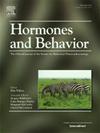Examining androgen and estrogen profiles during pubertal development in autistic and neurotypical girls
IF 2.4
3区 医学
Q2 BEHAVIORAL SCIENCES
引用次数: 0
Abstract
Background
Puberty is a normative albeit complex developmental period marked by significant changes in hormonal, physical, and socioemotional functioning. Research has theorized an important role for sex hormones in the etiology and profile of autism spectrum disorder (ASD), especially during developmental periods including puberty. Differences in pubertal onset in autistic compared to neurotypical girls have been reported. Aims examined female participants based on diagnostic (autistic, neurotypical) and hormonal expression (dehydroepiandrosterone (DHEA-S), estradiol, testosterone) in the context of development (puberty, age). Hypotheses included: Hyp 1: autistic compared to neurotypical girls would demonstrate earlier pubertal onset. Hyp 2: DHEA-S and estradiol would be higher in older, more physically mature girls. Hyp 3: Testosterone would be stable.
Methods
Participants included females between 6-to-12 years with ASD (N = 112) or typical development (TD, N = 96). Morning salivary samples were collected for hormone assays. Nonlinear least squares and ordinary linear regression models were used.
Results
Autistic girls did not show significant evidence of earlier pubertal onset in pubertal stage (p = 0.692). There were no observed diagnostic differences in hormone changes through the pubertal or age range (p = 0.8367, p = 0.0694, p = 0.6812, p = 0.8418, p = 0.7358, & p = 0.1438) sampled. All hormones showed significant changes with puberty and age (p < 0.001).
Conclusions
The study examined profiles of females based on diagnostic group and hormonal expression in the context of development. Although group differences were not observed in this cross-sectional study, hormonal differences may emerge as girls progress through puberty. It is vital to track and support autistic girls through this time of change and vulnerability.
在自闭症和神经正常女孩的青春期发育过程中检查雄激素和雌激素谱。
背景:青春期是一个规范而复杂的发育时期,以激素、身体和社会情感功能的显著变化为特征。从理论上讲,性激素在自闭症谱系障碍(ASD)的病因和特征中起着重要作用,特别是在包括青春期在内的发育时期。孤独症女孩与神经正常女孩在青春期发病的差异已经有报道。目的是根据诊断(自闭症,神经正常)和激素表达(脱氢表雄酮(DHEA-S),雌二醇,睾酮)在发育(青春期,年龄)背景下对女性参与者进行检查。假设包括:假说1:与正常的女孩相比,自闭症女孩会表现出更早的青春期开始。Hyp 2: DHEA-S和雌二醇在年龄更大、身体更成熟的女孩中会更高。假说3:睾酮会很稳定。方法:参与者包括6- 12岁患有ASD (N = 112)或典型发育(TD, N = 96)的女性。早上采集唾液样本进行激素检测。采用非线性最小二乘法和普通线性回归模型。结果:孤独症女孩在发育期无显著性早熟迹象(p = 0.692)。在不同年龄段和不同年龄阶段,激素变化的诊断差异无统计学意义(p = 0.8367, p = 0.0694, p = 0.6812, p = 0.8418, p = 0.7358, p = 0.1438)。所有激素均随青春期和年龄发生显著变化(p)。结论:本研究基于诊断组和发育背景下激素表达检查了女性的概况。虽然在这项横断面研究中没有观察到组间差异,但随着女孩进入青春期,激素差异可能会出现。跟踪和支持自闭症女孩度过这一变化和脆弱的时期至关重要。
本文章由计算机程序翻译,如有差异,请以英文原文为准。
求助全文
约1分钟内获得全文
求助全文
来源期刊

Hormones and Behavior
医学-行为科学
CiteScore
6.70
自引率
8.60%
发文量
139
审稿时长
91 days
期刊介绍:
Hormones and Behavior publishes original research articles, reviews and special issues concerning hormone-brain-behavior relationships, broadly defined. The journal''s scope ranges from laboratory and field studies concerning neuroendocrine as well as endocrine mechanisms controlling the development or adult expression of behavior to studies concerning the environmental control and evolutionary significance of hormone-behavior relationships. The journal welcomes studies conducted on species ranging from invertebrates to mammals, including humans.
 求助内容:
求助内容: 应助结果提醒方式:
应助结果提醒方式:


